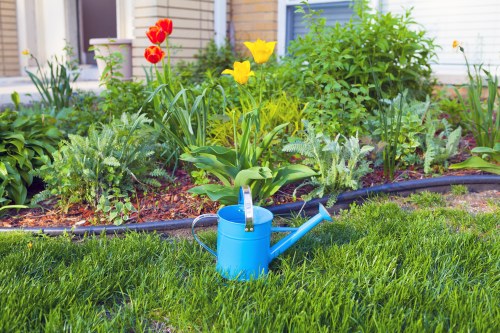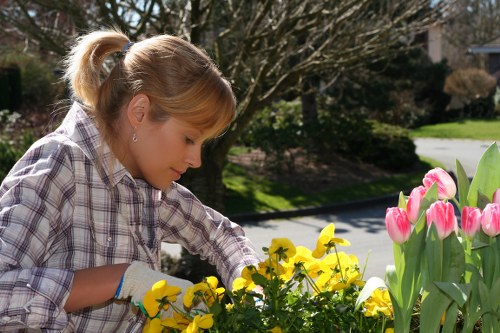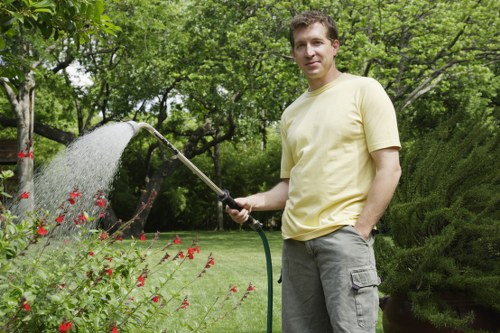Comprehensive Guide to Garden Maintenance in Abbey Wood

Maintaining a beautiful garden in Abbey Wood requires dedication, knowledge, and the right techniques. Whether you're a seasoned gardener or a novice, understanding the unique aspects of garden care in this area can help you achieve a thriving outdoor space.
Abbey Wood's climate and soil conditions play a significant role in determining the types of plants that will flourish. By selecting appropriate flora and implementing effective maintenance practices, you can ensure your garden remains picturesque throughout the year.
Regular maintenance not only enhances the aesthetic appeal of your garden but also promotes the health and longevity of your plants. From pruning to fertilizing, each task contributes to a well-balanced ecosystem.
Understanding Abbey Wood's Climate

Abbey Wood experiences a temperate climate, characterized by mild winters and warm summers. This climate is conducive to a wide variety of plants, allowing for diverse garden designs.
However, occasional heavy rains and sudden temperature fluctuations can pose challenges. It's essential to choose plants that are resilient and can adapt to these conditions.
Implementing proper drainage systems and selecting frost-resistant plants can mitigate the adverse effects of unexpected weather changes.
Soil Preparation and Improvement

The soil in Abbey Wood varies, with some areas having clay-heavy ground while others are more sandy. Understanding your soil type is the first step in effective garden maintenance.
Clay soils retain water, which can lead to root rot if not managed properly. To improve drainage, consider incorporating organic matter such as compost or well-rotted manure.
Sandy soils, on the other hand, drain quickly and may require the addition of organic materials to enhance moisture retention and nutrient content.
Plant Selection for Abbey Wood Gardens

Choosing the right plants is crucial for a successful garden. In Abbey Wood, consider native species that are well-adapted to the local climate and soil conditions.
Perennials, annuals, shrubs, and trees each play a unique role in garden design. Incorporating a mix ensures year-round interest and a balanced ecosystem.
Some popular choices include lavender, hydrangeas, roses, and ornamental grasses, which thrive in the region's environment.
Seasonal Maintenance Tasks
- Spring: Prepare beds, plant new varieties, and start regular watering schedules.
- Summer: Focus on weeding, pruning, and pest control to maintain plant health.
- Autumn: Clean up fallen leaves, mulch beds, and prepare plants for winter.
- Winter: Protect sensitive plants, plan for the next season, and perform tool maintenance.

Proper seasonal maintenance ensures that your garden remains vibrant and resilient throughout the year. Adapting your practices to the changing seasons can prevent common issues and promote healthy growth.
Additionally, seasonal tasks provide an opportunity to refresh your garden design, introducing new plants or rearranging existing ones to enhance the overall layout.
Consistency in maintenance routines is key to achieving long-term garden success in Abbey Wood.
Watering and Irrigation Strategies
Effective watering is fundamental to garden maintenance. In Abbey Wood, balancing water usage to meet plant needs without overwatering is essential.
Implementing drip irrigation systems can provide targeted watering, reducing water waste and ensuring plants receive consistent moisture.
Rainwater harvesting is another sustainable option, allowing you to utilize natural rainfall and minimize reliance on municipal water sources.
Mulching around plants helps retain soil moisture, suppress weeds, and regulate soil temperature. Organic mulches, such as bark or straw, also contribute to soil fertility as they decompose.
Monitoring soil moisture levels and adjusting your watering schedule accordingly can prevent common issues like root rot and drought stress.
Consider investing in a moisture meter to accurately assess the hydration needs of your garden.
Pest and Disease Management
Maintaining a healthy garden involves proactive pest and disease management. Regular inspections can help identify issues early, allowing for timely intervention.
Encouraging beneficial insects, such as ladybugs and lacewings, can naturally control pest populations without the need for chemical pesticides.
In cases of severe infestations, opt for eco-friendly treatments to protect both your plants and the surrounding environment.
Implementing integrated pest management (IPM) strategies can provide a comprehensive approach to maintaining garden health. This includes cultural, biological, and mechanical controls tailored to specific challenges.
Maintaining plant diversity and avoiding monocultures can also reduce vulnerability to pests and diseases.
Educate yourself on the common pests and diseases in Abbey Wood to better prepare and respond to potential threats.
Pruning and Trimming Techniques
Regular pruning and trimming are essential for shaping plants, promoting healthy growth, and preventing the spread of diseases.
Different plants require specific pruning techniques. For example, flowering shrubs might need to be trimmed after blooming, while fruit trees benefit from annual pruning to enhance fruit production.
Using the right tools and following proper methods ensures that pruning is effective and minimizes harm to the plants.
Pruning also helps improve air circulation within the garden, reducing the risk of fungal infections and promoting stronger plant structures.
Deadheading spent flowers encourages plants to produce more blooms, maintaining a vibrant and lively garden.
For best results, familiarize yourself with the pruning requirements of each plant species in your garden.
Fertilization and Soil Nutrition
Feeding your plants with the right nutrients is crucial for their growth and overall health. Soil testing can help determine the nutrient composition and identify any deficiencies.
Based on the results, choose appropriate fertilizers to supplement the soil. Organic options, such as compost and fish emulsion, provide a natural boost without harming the environment.
A balanced fertilization schedule ensures that plants receive essential nutrients throughout their growth cycle, supporting robust and healthy development.
Over-fertilization can lead to nutrient imbalances and environmental pollution, so it's important to follow recommended application rates.
Incorporating cover crops and green manures can enhance soil fertility naturally, improving its structure and nutrient-holding capacity.
Regularly amending the soil with organic matter maintains its health and supports sustainable garden growth.
Lawn Care and Maintenance
A well-maintained lawn is a cornerstone of any garden. In Abbey Wood, regular mowing, aeration, and fertilization keep your grass healthy and lush.
Choosing the right grass variety that thrives in the local climate ensures resilience against pests, diseases, and environmental stresses.
Implementing proper mowing techniques, such as cutting at the optimal height and sharpening blades, promotes vigorous growth and prevents grass damage.
Aerating your lawn annually helps alleviate soil compaction, allowing air, water, and nutrients to reach the grassroots effectively.
Overseeding can fill in bare spots and enhance the density of your lawn, creating a more uniform and attractive appearance.
Regularly dethatching removes the layer of dead grass and debris, improving airflow and reducing the risk of fungal diseases.
Garden Tools and Equipment
Investing in quality garden tools and equipment can significantly streamline your maintenance tasks. Essential tools include pruning shears, spades, rakes, and watering systems.
Regular maintenance of your tools, such as cleaning and sharpening, ensures their longevity and effectiveness in the garden.
Consider eco-friendly options, such as manual tools or solar-powered equipment, to reduce your garden's environmental impact.
Storage solutions, like sheds or tool racks, keep your equipment organized and protected from the elements, extending their usable life.
Ergonomic designs minimize physical strain, making garden maintenance more comfortable and efficient.
Investing in multi-functional tools can save space and money, providing versatility for various garden tasks.
Hardscaping and Garden Structures
Incorporating hardscaping elements, such as paths, patios, and pergolas, enhances the functionality and aesthetic appeal of your garden.
Proper planning and selection of materials ensure that these structures complement your garden's design while providing practical benefits.
Regular maintenance of hardscaping elements, including cleaning and repairing, extends their lifespan and maintains a polished look.
Garden lighting adds ambiance and safety, allowing you to enjoy your outdoor space during the evening hours.
Installing irrigation systems within hardscape designs can streamline watering processes, ensuring efficient and consistent moisture distribution.
Choosing durable and weather-resistant materials for structures ensures they withstand Abbey Wood's climate conditions.
Sustainable Gardening Practices
Adopting sustainable practices in garden maintenance promotes environmental responsibility and long-term garden health.
Techniques such as composting, rainwater harvesting, and using native plants reduce resource consumption and support local ecosystems.
Minimizing chemical usage by opting for organic fertilizers and pest control methods fosters a healthier garden environment.
Implementing crop rotation and companion planting can enhance soil fertility and deter pests naturally.
Reducing waste through recycling garden trimmings and repurposing materials contributes to a more sustainable garden.
Educating yourself on sustainable gardening practices empowers you to make informed decisions that benefit both your garden and the planet.
Professional Garden Maintenance Services
For those seeking expert assistance, professional garden maintenance services in Abbey Wood offer comprehensive care tailored to your specific needs.
Experienced gardeners provide services such as landscape design, regular maintenance, and specialized treatments to ensure your garden thrives.
Hiring professionals can save time and effort, allowing you to enjoy a well-maintained garden without the hassle of handling all tasks yourself.
Professional services often include seasonal clean-ups, plant health assessments, and customized care plans to address unique garden challenges.
Collaborating with experts ensures that your garden receives the attention and expertise required for optimal growth and beauty.
Investing in professional maintenance can enhance property value and create a welcoming outdoor space for relaxation and entertainment.
DIY Garden Maintenance Tips
For those who prefer a hands-on approach, DIY garden maintenance offers the flexibility to manage tasks at your own pace.
Creating a maintenance schedule helps organize tasks and ensures that essential activities are performed consistently.
Educate yourself on gardening techniques through books, online resources, and local workshops to enhance your skills and knowledge.
Start with manageable projects, such as planting a small flower bed or installing a simple irrigation system, to build confidence and experience.
Joining local gardening clubs or online communities provides support, inspiration, and advice from fellow enthusiasts.
Experimenting with different plants and techniques can lead to a more personalized and rewarding gardening experience.
Conclusion
Effective garden maintenance in Abbey Wood combines understanding the local climate, selecting appropriate plants, and implementing sustainable practices. Whether you choose to manage your garden yourself or enlist professional help, consistent care and informed decisions are key to cultivating a beautiful and healthy outdoor space.
By following the guidelines outlined in this article, you can create a thriving garden that enhances your home's appeal and provides a peaceful retreat for years to come.
Don't wait any longer—contact us today to start transforming your garden into the oasis you've always dreamed of.